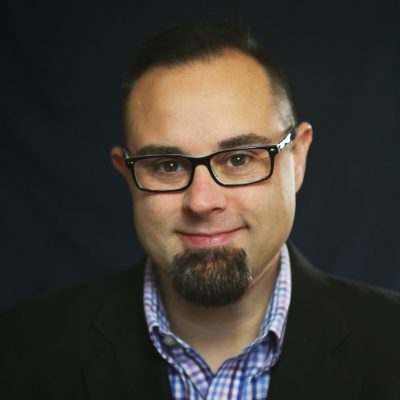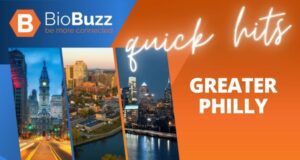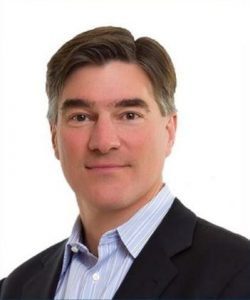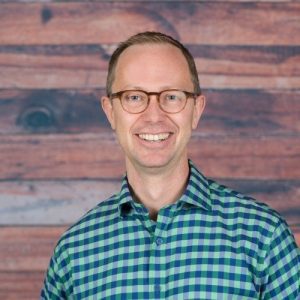
5 Questions With Michael Nestor, Ph.D., Scientific Engagement Lead at Johnson & Johnson Innovation, JLABS @ Washington, DC
“5 Questions With…” is a weekly BioBuzz series where we reach out to interesting people to share a little about themselves, their work, and maybe something completely unrelated. This week we welcome Michael Nestor, Ph.D., Scientific Engagement Lead at Johnson & Johnson Innovation – JLABS (JLABS) @ Washington, D.C.
As Scientific Engagement Lead, Michael is responsible for external scientific engagement with regional academic research institutions, start-ups, investment partners, and portfolio management. He collaborates with the Head of JLABS @ Washington, DC and Johnson & Johnson Innovation colleagues in sourcing and evaluating innovative companies with the aim to foster a productive life science ecosystem and bring value to the pipeline of the Johnson & Johnson Family of Companies (Johnson & Johnson).
Michael received his Ph.D. in Neuroscience from The University of Maryland, School of Medicine, and completed postdoctoral fellowships at the National Institutes of Health and The New York Stem Cell Foundation, where he was also a Staff Scientist. Michael was also an NIH IRACDA Fellow at Rutgers University, focused on teaching in minority-serving institutions and helping increase the participation of traditionally underrepresented groups in science.
He was Director of Neural Stem Cell Research at The Hussman Institute for Autism where he led his own lab studying autism by creating brain organoids from human induced pluripotent stem cells. His lab developed a multiplexed high-throughput CRISPR and drug-screening platform.
Michael served as Co-Chair of the Neural Stem Cell Working Group at the University of Maryland, School of Medicine and as a venture advisor to the UM Momentum Fund and the Abell Foundation. Further, he was an American Association for the Advancement of Science (AAAS), Science and Technology Policy Fellow in the Office of Science at The Department of Energy (DOE). At the DOE, Michael was focused on synthetic biology, artificial intelligence, and biosecurity initiatives. Michael also launched his own human stem cell consulting company, Synapstem.
1) Please introduce yourself to our audience by looking back at your education, training, and career.
I have been fortunate to have had training and a career that nicely bridges the three main pillars of scientific innovation and research in the US-academia, industry, and government. I keep in mind that it is the journey that is the reward in this space, not the destination-and that has served me well as I try to build bridges of innovation. That said I have always worked at the intersection between traditional academia and biotech, and it is the best of both worlds!
I started in an academic pre-clinical research environment focused on molecular/cellular neuroscience, advanced imaging, and electrophysiology in animal models. Based on my desire to move further into translational neuroscience I took a postdoctoral fellowship at the National Institutes of Health (NIH) to build on my pre-clinical research (and at the time, compared to other postdoctoral fellowships, the pay/benefits were great too!)
While at the NIH, I interacted with Dr. Ron McKay who inspired me to use human stem cells to model human disease. However, at the time, it was sometimes difficult to work with human stem cells. For that reason, I moved to The New York Stem Cell Foundation (NYSCF), which was, at that time located in the Lasker Building on the Columbia University Medical Center campus. This was a huge opportunity to work in a more biotech/startup-like environment with the foremost experts in human stem cells and in an organization that bridged the “valley of death” between academia and industry.
At NYSCF, I completed a short second postdoctoral fellow position and then moved to staff scientist. I knew I wanted to be more involved in helping my colleagues who I saw first-hand were denied opportunities because of their socioeconomic background. To that end, I asked if I could split some time between NYSCF as a staff scientist and Rutgers University as an NIH IRACDA Fellow, and I am very thankful that my wonderful advisor at NYSCF said yes. The Rutgers Inspire Program allowed me to obtain specific training to teach and advise scientists in minority-serving institutions and I was able to gain valuable experience teaching students at Medgar Evers College, an HBCU in Brooklyn, NY. I wanted to help bring the unique academic/biotech pipeline I experienced closer to these budding scientists from historically underserved communities. One of the things that attracted me to JLABS is our mission to help drive entrepreneurship and innovation in these same communities.
Because of the nature of my work (and the expense!) in developing brain organoid models using human induced pluripotent stem cells, and because I had aspirations of bridging biotech and academia in my own lab, I knew starting my own group in a traditional academic environment would be a challenge. Therefore, I started as a Principal Investigator and moved to Director of Human Stem Cell Neurophysiology at The Hussman Institute for Autism—a non-profit research institute where I also had an academic appointment. This allowed me to have both a traditional academic lab, where I wrote grants and supervised staff, but also pursued translational work in a start-up like environment. To that end, and due to my desire to want to spin out a platform screening technology we developed at the institute, I started my own company, Synapstem.
Ultimately, that company morphed into a consulting company while I was getting more and more involved in policy issues surrounding the use of CRISPR in human stem cells. I reasoned that understanding the policy around science funding in cell and gene therapy would help me write more impactful (read: funded!) NIH grants. This drove me to advocacy work with The Society for Neuroscience and the AAAS Science and Technology Policy Fellowships (SPTF). This all led me to JLABS, which, if you have read this far, you can see is the right place to continue my translational work in the commercial space.
2) Tell us more about your role as Scientific Engagement Lead – what does this role entail, and what do you enjoy most about this current position?
The Scientific Engagement Lead role at JLABS is a very interesting (and fun!) position that sits at the interface between our scientific and business units internally, and crosses science and commercialization in the external space. Part of my role is in the search and evaluation of innovative technologies in the external space to find companies that we can partner or collaborate with at Johnson & Johnson. This requires a mix of scouting, diligence, outreach activities as well as internal portfolio management, scientific thought leadership, and project management. It is a great role because it is truly de-siloed. Not only do I work across all our scientific/business sectors (Pharmaceuticals, Medical Devices, Consumer Health), but I also am able to work with our internal experts on cross-sector initiatives like our World Without Disease Accelerator and our Lung Cancer Initiative.
I really enjoy working with my colleague, Rachel Rath, Director of the BLUE KNIGHT™ program, a collaboration between Johnson & Johnson Innovation – JLABS and the Biomedical Advanced Research and Development Authority (BARDA) on finding innovative companies in our region that align with BLUE KNIGHT™ areas of interest. This is really a great public-private collaboration and dovetails well with my policy/government experience.
Building a pipeline of early-stage companies that are deeply engaged in our region is very satisfying for me because of my roots in the DMV, having grown up and completed most of my education in Maryland. I feel our region is unique and has opportunities for healthcare discovery that are equally unique. Fostering a life sciences innovation environment in the DMV and regionally in the Mid-Atlantic and Southeast with the aim to drive treatments to patients is meaningful work, and work that I truly enjoy.
Part of that work requires me to get out there and talk with diverse sets of stakeholders from entrepreneurs, businesspeople, scientists, and government staff across all the sectors I mentioned before. I must admit that sometimes the scientific discussion is so exciting, that I am inspired to put my lab coat right back on, pick up the pipettes and get to work at the bench again. That is the great thing about this job. I can engage in the science, even making suggestions about what experiment might be needed or how to take a different approach with statistical analysis as well as talk about the business aspects—what series raise the company is at, what does the IP protection look like, what is the revenue plan, etc.
That is the best part of the job—I love to learn and ask hard questions about cutting edge science and be at the interface between that science and commercialization. Those conversations are, by far, the most fun. I really like to meet really driven people who have a passion to help others, and there is no shortage of those people in our region!
I want to hear from you about your science, please connect. You can learn more about Johnson & Johnson – Innovation, JLABS @ Washington, DC: https://jlabs.jnjinnovation.com/locations/jlabs-washington-dc
If you want to apply to be considered for residency at JLABS, you can do so here: https://jlabsresidency.smapply.io/
3) You also completed an AAAS Executive Branch Science & Technology Fellowship. How did this experience add value to your career, and do you have advice for folks out there who are looking to apply for this opportunity?
Every AAAS STPF will tell you it changed their lives. Although it was a very difficult decision to try to split time between running my own lab and an intensive fellowship (I fully expected not to sleep much considering I also have a young family that I am fully devoted to spending time with), it was the best decision of my career.
But the value was so much more than that—and it is kind of hard to put into words because of the many layers. Professionally, of course you are networked into a cohort of people that you form bonds with and friendships with that will last a lifetime. And then there is the experience of stretching yourself out of your comfort zone and working on big, difficult problems that have society-wide impact. I specifically chose to work at an agency that was not doing work I was familiar with. Although a natural choice would have been to work in policy at the NIH, I chose to work at the DOE. The growth that happens when you stretch yourself like that is amazing, especially because you learn how to get comfortable with the feeling of being uncomfortable, so to speak.
In my opinion, the most career-changing aspect of the AAAS STPF is psychological. Imagine yourself as a scientist who is good at what you do but always finding yourself wondering, “could I do more?” Imagine attending events and talks and thinking, “this is great but how can I add more meaning to all of this, how can I add even more impact?” Validation, belonging, and finding people who care as deeply as you do about these other aspects of science has such a huge emotional impact (at least for me it did). It gave me the confidence to move into a role like the one I have at JLABS. I am not sure I could have achieved that without the AAAS program.
My advice to apply besides “just do it” is to find former fellows and talk with them. They all love to talk about their experiences and will talk with you. It is ok to be a little random and just cold email. You will get more insight about how to apply and what this experience is like than you ever will reading the materials online. But seriously, just apply—applying itself with stretch you.
4) What type of projects/milestones are you most excited about in the coming year?
We are in a growth phase at Johnson & Johnson Innovation – JLABS @ DC and I am really looking forward to deepening our relationships in the ecosystem to drive innovation to marketplace as soon as possible. This includes developing more connections between Johnson & Johnson Innovation – JLABS and our academic partners where investigators might be thinking about spinning out companies from their labs. In addition, I am really excited about the prospect of growing our connections with scientific societies looking towards innovation and our state and local government partners. I think that working with people who are passionate about getting from bench to bedside in a safe but timely manner continues to be what I look forward to.
I am ready to get back out there and meet people in person and on campus. I love hearing about your science and finding ways that I can help you advance it!
5) What’s your favorite thing to do in the city in your free time? (DC or Baltimore…you pick!)
I can’t pick! Love both cities and what a great region that we have both. They each have their charm (although Baltimore does call itself “Charm City.”) I am a musician and play out live a lot (or I used to before the pandemic) and so I really enjoy going to the local music venues. I also love hanging out in bookstores/coffeeshops and looking for vinyl records when I have the chance.
- About the Author
- Latest Posts
BioBuzz is a community led, experience focused, biotech and life sciences media and events company. BioBuzz highlights regional breaking news, industry professionals, jobs, events, and resources for business and career growth. Their weekly newsletter is subscribed to by thousands in the BioHealth Capital Region and Greater Philadelphia as the go-to for industry updates.





